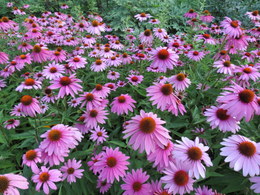Coneflower Growing Guide
Coneflower (Echinacea purpurea) is a perennial wildflower native to eastern and central North America and will do well in USDA Zones 4 to 9 and prefer full sun.
Coneflowers are in the Aster family with large purple flowers that appear in midsummer through fall. They reach an average height of 36-inches and spread 15 to 18-inches. Plant breeders have added other vibrant colors which now include purple, rose, pink, white, yellow and lime green.
In addition to being deer resistant coneflowers are a nectar plant for butterflies such as the Monarch, Tiger Swallowtail, Viceroy and Painted Lady. In the fall when the seed heads dry out the seeds will attract goldfinches and other songbirds as well as self-seed.
Starting from Seed
Follow the seed packet instructions, seeds can be started indoors 4 to 6-weeks before your last expected frost date.
Sow seed 1/4-inch deep. Germination takes 10 to 20-days.
For more detailed information visit the seed starting page.
You can direct sow in your flower garden from the late spring to early summer. A large mass planting makes an impressive floral display.
Soil Preparation
Plant them in full sun and in a nice loose well-drained garden soil and do best in a slightly acid soil with a pH range of 6.0 to 7.0.
Planting
Coneflowers should be planted in the late spring after the last expected frost.
Plant them 18 to 24-inches apart or in groups of 3 or 5 behind other shorter plants. Dig a hole as deep as the pot and twice as wide. To the soil you just removed add the same amount of good garden soil so you have a nice blend of new and native soil.
Take the plant out of the pot and gently loosen the root ball pulling away any roots that have grown in a circle around the pot.
Place the root ball in the hole with the growing crown of the plant even with or an inch higher than the surrounding soil. Gently spread out the roots and back fill the hole around the root ball leaving a shallow depression around your plant. Fill the depression with water to settle the soil around the roots adding more soil if necessary and water again. Water daily tapering off as the roots grow and get established.
Dividing Your Plants
After many years the center of the mature plant may die out, leaving the newer growth from the rhizomes. It usually becomes most apparent after a hard frost hits and the center becomes visible.
Doing the divisions every 3 to 5-years helps to rejuvenate the plant. To help prevent the spread of disease you should disinfect your garden tools and knife with a 10% bleach solution.
In the early spring about 4 to 6-weeks before the last frost date occurs and before growth begins, you can divide the clump into two, three or four sections.
Some gardeners will use a knife or a shovel to slice off a portion of the plant. A better way is to dig up the entire plant. Now you can see what you have. If you wash the soil off of the roots the entire rhizome and root structure can be seen.
Examine the rhizomes for the eyes or growing buds and carefully try to break it apart with your hands and then tease the roots apart. If necessary use a knife to separate the rhizomes.
You will now have more new plants that are identical to each other to replant or give away.
Watering and Care
Coneflowers are low maintenance and easy to care for. All you need to do is add a layer of mulch to help retain moisture and keep out competing weeds. They should get an inch of water each week and during dry spells give some water to keep the soil moist. They usually do not need any fertilizer, but a light side dressing of organic fertilizer can be placed around the plant in the spring.
Diseases and Pests
They are relatively free of diseases and pests. Occasionally powdery mildew, bacterial leaf spot, gray mold may be a problem in some areas. Use resistant varieties and thin plants to increase air circulation.
Japanese beetles may occur and can be controlled by hand picking early in the morning. Hold a container of soapy water under the Japanese beetle and then tap the leaf or flower and it will usually drop into the soapy water.
Popular Coneflower Varieties
Popular varieties are Alba, Bravado, Bright Star, Cheyenne Spirit, Doubledecker, Magnus, Prairie Splendor, Pow Wow Wild Berry, White Swan.
Sources: Burpee, Jung Seed, Park Seed
Garden Spikes newsletters give you timely information once or twice a month. Subscribe Free to the Garden Times newsletter below.
Your email address will only be used to send you a newsletter and will never be sold. You can unsubscribe at any time.

